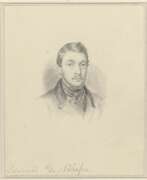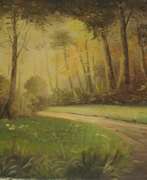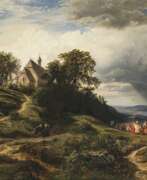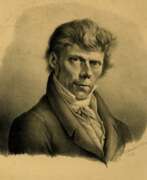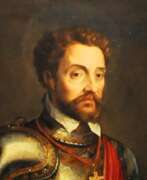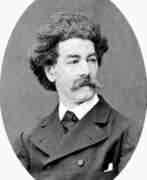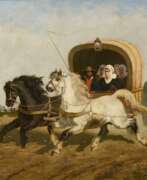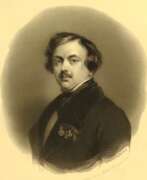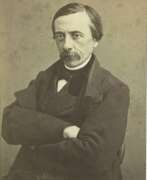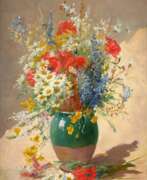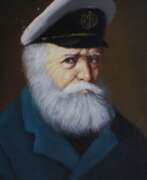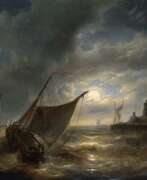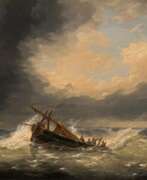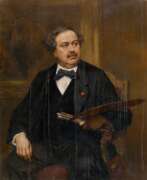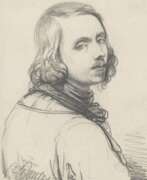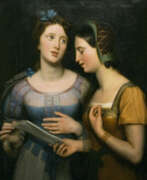Belgium Romanticism


Euphrosine Beernaert was a Belgian landscape painter. She studied under Pierre-Louis Kuhnen in Brussels. She travelled in Germany, France, and Italy, and exhibited landscapes at Brussels, Antwerp, and Paris, her favorite subjects being Dutch. In 1873, she won a medal at Vienna; in 1875, a gold medal at the Brussels Salon; and still other medals at Philadelphia, Sydney and Teplitz. She was made Chevalier de l'Ordre de Leopold in 1881.


Jacques François Joseph Carabain was a Dutch-Belgian painter, known primarily for his scenes of cities and buildings in the Romantic-Realist style. He was especially interested in Medieval and Baroque structures, and was often attracted to busy market places.


Charles Ferdinand Ceramano, born Charles Ferdinand Semain, was a Belgian painter and illustrator of the Barbizon school.
Ceramano's favorite subjects were pastoral landscapes and scenes of sheep in a sheepfold or in a meadow.
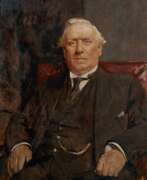

André Edmond Alfred Cluysenaar was a Belgian painter. He was especially known for portraits and female figures. He was member of the Cluysenaar family, descendant from a long line of architects who originated in Aachen. He received his first art lessons from his father, then studied with François-Joseph Navez. Initially, he worked as a sculptor, but devoted himself entirely to painting after 1902. He was firmly grounded in the romantic style at first; producing still lifes and genre scenes, but later turned to impressionism and painted mostly female figures, often semi-nude. He also executed monumental ceiling paintings for the City Hall in Saint-Gilles. During World War I, he lived in London where he established a reputation painting portraits of notable people, including the Royal Family, which were done in a more commercial style using Alfred Stevens as a model. Most of these portraits may be seen in the National Gallery.


Jan-Baptiste Daveluz is a Belgian landscape painter. Studied at the Art Academy in Kortrijk under Jan Baptiste de Jonge. He mainly painted the highlands of West Flanders, the Flemish Ardennes, the Meuse Valley and the Moselle Valley. His landscapes are idyllic and correspond to the era of romanticism. The painting "The Four Seasons" from the museum in Kortrijk is remarkable: the panel is divided into four areas and shows the same landscape in the changing conditions of the four seasons.
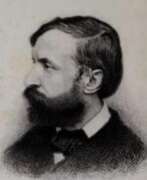

Charles Corneille Auguste de Groux or Charles Degroux was a French painter, engraver, lithographer and illustrator. As he moved to Belgium at a young age and his whole career took place in Belgium he is usually referred to as a Belgian artist. His depictions of scenes from the life of the disadvantaged and lower-class people of his time mark him as the first Belgian social realist painter. These works made him the precursor of Belgian Realist artists such as Constantin Meunier and Eugène Laermans. De Groux worked in different media, including oil painting, watercolor, pastel, engraving and lithography. He started out as a painter of history and religious scenes in the Romantic style then prevalent in Belgium. He later developed his own realist style which shows the influence of Courbet as well as genre painters of the 17th century. De Groux' social realist works contain many religious overtones and references.


Theodore Bernard de Heuvel was a 19th-century Belgian genre painter.
De Heuvel specialized in domestic genre scenes, often involving children. For example, his paintings of a village classroom where a strict teacher is teaching a lesson to tomboys, or other cute domestic scenes are widely known.


David Emile Joseph de Noter is a Belgian painter-painter.
His grandfather Peter-France de Noter and father Jean-Baptiste André de Noter were painters, and he received his first artistic education from them. David de Noter painted still lifes and genre paintings in which he carefully sketched out the smallest details.
The artist often traveled to French Algeria and exhibited in Parisian salons.
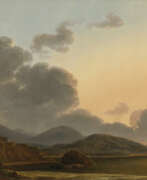

Simon Denis, a Belgian painter, is celebrated for his significant contributions to landscape painting. His journey in art took him from his native Antwerp, where he initially honed his skills under the tutelage of landscape and animal painter H.-J. Antonissen, to the bustling artistic scenes of Paris and ultimately to Italy, where he spent the majority of his career.
Denis's move to Rome in 1786, facilitated by the support of genre painter and art dealer Jean-Baptiste-Pierre Lebrun, marked the beginning of a prolific period in which his work attracted favorable attention. His marriage to a local woman in 1787 and his active participation in both the Flemish and French artistic communities in Rome underscore his integration into and influence on the local art scene. Notably, his technique was characterized by an exact and detailed approach, especially in his depictions of famous Italian landscapes, such as the waterfalls of Tivoli near Rome. This meticulous attention to naturalistic details and light effects distinguished his work during his time in Italy.
Denis's election to the prestigious Accademia di San Luca in 1803 attests to his recognition among his peers. In 1806, he settled in Naples, where he became the court painter to Joseph Bonaparte and later a professor at the Accademia di Belle Arti. His influence extended to teaching, with landscape painter Prosper Barrigue de Fontainieu among his pupils, demonstrating his role in shaping the next generation of artists.
Simon Denis's works, including "Study of Clouds with a Sunset near Rome" and "Landscape near Rome during a Storm," are held in prestigious collections such as the J. Paul Getty Museum and The Metropolitan Museum of Art, ensuring his lasting legacy in the annals of art history. For collectors and experts in art and antiques, Denis's oeuvre offers a window into the evolution of landscape painting, characterized by an immersive exploration of nature and meticulous attention to atmospheric effects.
To stay informed about new discoveries, sales, and auctions related to Simon Denis's works, signing up for our newsletter is recommended. This subscription is an invaluable resource for those looking to deepen their understanding of Denis's impact on landscape painting and to keep abreast of opportunities to acquire pieces by this masterful Belgian artist.
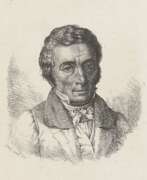

Frédéric Théodore Faber was a Belgian landscape and genre painter. He established at Brussels a china manufactory, and abandoned painting on canvas for painting on porcelain. He also etched upwards of a hundred plates of landscapes and animals, some after his own designs.
A significant set of pieces painted by this virtuoso is exhibited at the Museum of Decorative Arts François Duesberg.


Louis Gallait was a Belgian painter. He lay at the basis of a revival of history painting in Belgium. He earned his reputation especially with the large painting of Charles V's abdication. Gallait's works were esteemed because of their realism, faithfulness of the costumes and color composition of his paintings. He was also a distinguished portrait painter.


Jan Baptist Huysmans was a Belgian orientalist painter, traveler and writer.
After graduating from the Antwerp Academy, Jan Baptist Huysmans traveled extensively. During his long and prolific artistic career he visited Greece, Turkey, Syria, Palestine, Egypt and Algeria. These travels resulted in numerous sketches and studies, sketches, paintings and memoirs by the artist, who was fascinated by the culture and landscapes of the countries he saw.
In addition to genre paintings of Eastern life, the artist created religious compositions for churches in Jerusalem and decorative panels for church and municipal buildings in Belgian cities.
Huysmans lived most of his professional life in Paris and exhibited in France, England, and Scotland. He also published several illustrated books about his travels, notably Travels in Italy and the East in 1856-1857.
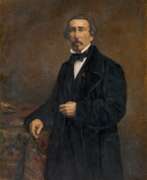

Jacobus Albertus Michael Jacobs, known as Jacob Jacobs was a Belgian landscape and seascape painter in the Romantic style, with a preference for northern and "oriental" scenes. His first exhibitions came in 1833. He took a trip to the North Sea in 1834, and a final study trip through the Netherlands in 1837 produced much material. In 1838, he left on a long sea voyage that would take him to Gibraltar, the North African coast, Egypt, the Dardanelles, Istanbul (where he remained for several months), Asiatic Turkey and Rhodes.[1] While in Ankara, he met and befriended his fellow Belgian painter, Florent Mols, and they continued travelling together; sailing down the Nile as far as Nubia. During these travels, he compiled two huge albums of drawings and notes that he would use for inspiration the rest of his life.


Hendrikus Johannes Knip or Henri Knip was a Dutch and Belgian landscape painter in the style of Dutch Romanticism and a draftsman.
A member of the Knip artistic dynasty: his father was the painter Matthäus Derk Knip (1785-1845), his grandfather was the painter Nicolaas Frederik Knip, and his uncles and aunts were also painters.
Hendrikus Knip worked in the Netherlands, Belgium, Italy and Switzerland.




Victor Lagye (1825–1896) was a Belgian 19th-century painter known for his genre scenes, historical and religious works. Born in Antwerp, he studied at the Royal Academy of Fine Arts there. He collaborated closely with the artist Henri Leys, contributing to large-scale murals and the restoration of historic buildings. His works are characterized by meticulous detail and attention to historical costumes and interiors.
Though talented, he remained overshadowed by more famous contemporaries. Some of his pieces are housed in the Royal Museum of Fine Arts Antwerp. Details about his birth and death locations, as well as his biography, are less documented compared to leading artists of his time.
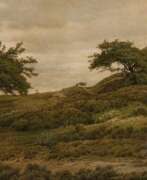

Jean Pierre François Lamorinière was a Belgian landscape painter best known for his realistic depictions of landscapes in his home country. His work is situated between the previous generation of the Romantic landscape painters and the Realist landscape. He painted his landscapes from nature based on his own observations. Even while his flat landscapes are derived from his direct observation of nature, Lamorinière did not just paint nature as he found it. He 'improved' on nature so that his compositions could meet the ideal spiritual image which he had of nature. This was reflected in the strict construction and detailed analysis of his compositions, which emphasized the static, and his smooth, meticulous style of painting. Important influences on his work were the Barbizon School as well as the landscape traditions of the Flemish and Dutch school. The artist preferred dark tones and usually depicted nature without any human presence. Lamorinière etched 24 plates, which were issued in 1874. The prints reveal the artist's grasp of the anatomy of trees and his attention to detail.
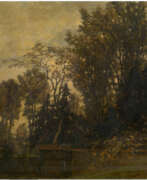

Joseph Henri Hubert Lies was a Belgian Romantic painter, draughtsman and engraver. He worked in a wide range of genres including history painting, landscapes, genre scenes and portraits. He enjoyed a European-wide reputation during his lifetime.


Egide (Egidius) Linnig was a Belgian painter, draughtsman and engraver. The subject matter of Linnig's work is mainly marines, ship portraits and coastal landscapes. He also had an interest in depicting the Flemish coastal towns. Linnig was an important representative of the Romantic-Realist movement in Belgian marine painting. Linnig's marine paintings are always well balanced and pay particular attention to topographical accuracy. His work provides an important testimony on the history of seafaring since he worked during the pivotal period that marked the transition from sailing ships to steamships. Linnig trained early on as an etcher and was one of the first to practise this art as an autonomous genre. He is regarded as one of the first realistic engravers in Belgium. His etchings, while technically finished, preserve a character of free and swift execution.
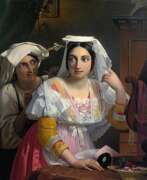

Jan Baptist Lodewyck Maes was a Belgian genre painter active in Italy. Maes studied at the Academy of Ghent. He exhibited for the first time at that city's fair in 1810. He won prizes in all the competitions he entered and in 1820 received a grant from the city of Ghent. Thanks to the Belgian Rome Prize received in 1821, he first visited Paris and then went on to Italy. In 1822 he copied works by old masters in the Uffizi Museum. In 1824 he settled in Rome. Maes kept in touch with his hometown and regularly sent works to Belgian salons. He was a corresponding member of the Royal Netherlands Academy of Sciences.


Balthasar Paul Ommeganck was a distinguished Flemish painter, born in Antwerp, Belgium, in 1755. He garnered acclaim for his unique approach to landscape painting, blending realism with an idealized portrayal of nature. Ommeganck's work is characterized by detailed observation of nature, a sure line, and subtle use of color. His favorite subjects were undulating landscapes, often featuring grazing animals like cows, sheep, and goats.
Balthasar Paul Ommeganck's talent was not confined to painting alone; he was also a skilled draughtsman and dabbled in sculpture, producing some clay models of sheep and cows. His main contribution to art was combining the light found in Dutch Italianate painters' work from the 17th century with meticulous observation of nature, finding a synthesis between realism and an idealized representation of nature.
In 1799, Balthasar Paul Ommeganck's landscape painting won the first prize in Paris, a competition he had not intended to enter but was submitted to by a friend. His success extended beyond the borders of Belgium, as he became a member of several academies, including those in Amsterdam, Brussels, Ghent, Munich, and Vienna. In 1809, he was recognized as a corresponding member of the Institut de France.
Despite his death in 1826, Balthasar Paul Ommeganck's style continued to influence landscape painting in the 18th and early 19th centuries. However, later art critics have sometimes viewed his adherence to classic tradition and preference for the picturesque and conventional as a form of 'hopeless traditionalism'.
For collectors and enthusiasts of art and antiques, Balthasar Paul Ommeganck's works represent a significant period in the history of landscape painting. His paintings, with their fusion of realistic detail and atmospheric beauty, are a testament to his skill and vision.
To keep abreast of the latest news, sales, and auction events related to Balthasar Paul Ommeganck's art, consider subscribing to our updates. This service ensures you stay informed about opportunities to delve deeper into the works of this notable landscape artist.
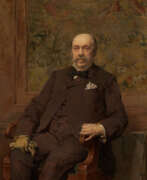

Jean-François Portaels was a distinguished Belgian painter. He is celebrated for his mastery in Orientalist art, genre scenes, and portraits. His education under the tutelage of François-Joseph Navez at the Academy of Brussels shaped his early artistic direction.
Portaels' career was marked by significant academic roles, including his tenure as the director of the Academy of Fine Arts in Ghent and later the Académie Royale des Beaux-Arts in Brussels. His influence extended beyond Belgium through his extensive travels across Europe and North Africa, where he absorbed and later depicted the exotic and vibrant cultures of Morocco, Algeria, Egypt, and Lebanon.
His works, such as "The Oriental Beauty" and "Portrait of Aouicha," are celebrated for their detailed depiction of Eastern subjects, characterized by elaborate costumes and serene expressions. These paintings not only display his technical skill but also his ability to convey the subtle nuances of different cultures.
Portaels was also a key figure in monumental art in Belgium, contributing to national identity through his historical and biblical scenes painted for many Belgian churches. His legacy is preserved in his contributions to the Belgian Orientalist school and his role in shaping the next generation of Belgian artists.
For collectors and experts in art and antiques, Jean-François Portaels' works offer a unique glimpse into the 19th-century Orientalist movement. To stay informed about exhibitions and sales featuring Portaels' art, sign up for our updates and ensure you don't miss out on acquiring a piece of this influential artist's legacy.


Henriette Ronner-Knip was a Dutch-Belgian artist celebrated for her detailed and emotive animal paintings, especially cats and dogs. Born into an artistic family in Amsterdam in 1821, Henriette's talent was evident early on, and she quickly became a prominent figure in the art world. Her father, a key influence in her life, helped hone her skills from a young age, emphasizing the dedication required for artistic success. Despite challenges, including her father's blindness and the responsibility of supporting her family, Henriette's resolve only strengthened.
After marrying Teiko Ronner in 1850, Henriette moved to Brussels, where she transitioned her focus predominantly to animals, capturing the essence and character of her subjects with remarkable precision. Her works, such as "The Death of a Friend," not only garnered acclaim but also reflected societal elements, like the reliance on dog sleds in the 19th century. Henriette's contributions were recognized with numerous accolades, and her legacy continued through her children, who also pursued artistic careers.
For collectors and art enthusiasts, Henriette Ronner-Knip's works offer a glimpse into the 19th-century life and a deep appreciation for animal portrayal in art. Her paintings, imbued with a blend of realism and romanticism, continue to resonate, reflecting her profound connection with her subjects and her exceptional skill in bringing them to life on canvas.
To stay updated on available pieces and auction events related to Henriette Ronner-Knip, signing up for updates can provide valuable insights and opportunities to acquire works by this distinguished artist.
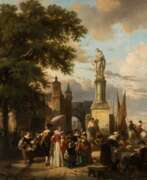

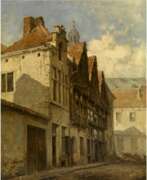

Hendrik Frans Schaefels or Henri François Schaefels, also known as Rik Schaefels was a Belgian Romantic painter, draughtsman and engraver known for his seascapes, cityscapes, genre paintings, landscapes with figures and history paintings. He worked in the Romantic style popular in Belgium in the mid nineteenth century and was highly esteemed in Europe for his representations of historic naval battles.


Henri Schouten is a Belgian animalist painter.
He studied at the Brussels Academy, where, under the influence of his teacher Alfred Vervy, he specialized in painting landscapes with cattle. Schouten depicted a wide variety of domestic animals and birds in their natural environment in a very naturalistic way, paying attention to their special character traits, as was fashionable at the time. His paintings were much loved by the wealthy Belgian bourgeoisie.
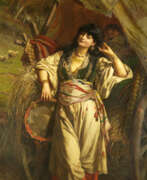



Frans Balthasar Solvyns, also known as François-Baltazard, was a Flemish painter, printmaker and ethnographer.
Solvyns trained in painting at the Academy of Fine Arts in Antwerp, then in Paris at the École Royale de Paintings et Sculpture, and was a successful marine painter in Antwerp, painting harbors and ships on government commissions.
In 1791 he arrived in Calcutta and lived there for several years, working and sketching. Solviyns documented 18th-century Indian culture and environment, including the people, their daily activities, holidays, culture, festivals, and religious practices. In 1796, Solvyns published his first collection of engravings entitled A Collection of Two Hundred and Fifty Colored Engravings: a Description of the Manners, Customs, and Dress of the Hindus in Calcutta.
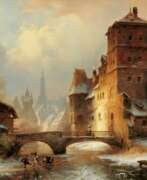

François Stroobant was a Belgian painter and lithographer. He attended the Brussels Académie des Beaux-Arts between 1832 and 1847. In 1835 he worked in the studio of the lithographer Antoine Dewasme-Plétinckx in Brussels. Stroobant's subjects were mainly landscapes and architecture. He travelled extensively through the Netherlands, France, Germany, Switzerland, Italy, Spain and Hungary, exhibiting in the galleries of the Belgian towns Ghent, Antwerp and Brussels. His romantic painting style stayed constant throughout his career. He was founder and first director in 1865 of the Académie des Beaux-Arts at Sint-Jans-Molenbeek in Brussels. In 1878 he was made an Officer in the Order of Leopold.


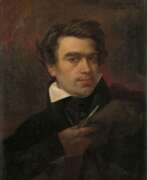

Pieter (Pierre) van Hanselaere was a Belgian painter in the neoclassical style, who specialized in portraits and religious and historical scenes. In his early days he specialized in portraiture and achieved a high level of technical perfection. Due to the Napoleonic wars he was not able to leave for Italy until 1816; when he did, he first stayed in Rome and painted portraits of some high-ranking officials, before moving to Naples and achieving success there as well, becoming the painter for the royal court.


Hubertus (Huib) van Hove was a Dutch painter, son of Bartholomeus van Hove and teacher of some of the painters who later became members of the Hague School.
Hubertus van Hove began as a landscape painter, but his best works belong to other genres. Van Hove's love of colour and bright light was evident in his domestic scenes in the style of Pieter de Hoch, depicting street views viewed through the door of a room or kitchen. The Teyler Museum holds a superb example of his work The Knitter, a painting with a lively composition and a brighter and fresher colouring.
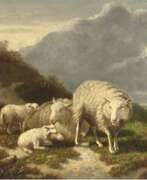

Cornelius van Leemputten is a Belgian animalist painter.
He attended classes at the Antwerp Academy of Art. His main subject was scenes of farm life with shepherds and grazing sheep in a romantic style. Van Leemputten was very industrious and painted many such pictures, as they were in demand among the wealthy public of the time.
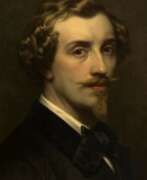

Joseph Henri François Van Lerius was a Belgian painter in the Romantic-Historical style. Van Lerius painted mythological and biblical scenes as well as portraits and genre pictures. Much of his work is didactic in nature. Perhaps his best-known work is "Lady Godiva", which was shown at the Antwerp Triennial Salon in 1870. Many of his works (especially "Lady Godiva" and "Cinderella") have been widely reproduced.
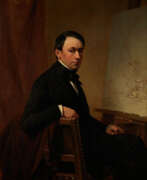

Eugène Joseph Verboeckhoven a Belgian painter, was born at Warneton in West Flanders. He was a painter, a sculptor, an etcher, an engraver, and a lithographer of animals, animated landscapes, and portraits.


Gaspar Peeter Verbruggen was a Flemish still life painter who is principally known for his decorative still lifes with flowers and fruit. He collaborated with figure artists on compositions which combined figures with a still life element. He was active in Antwerp and The Hague.
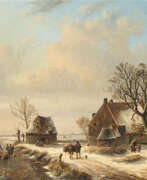

Louis-Pierre Verwee or Louis Pierre Verwée was a Belgian painter known for his rural landscapes with cattle and winter landscapes. He is the principal representative of the Romantic school in Belgian landscape painting characterised by a return to nature. His early works are similar to those of his master Verboeckhoven, to the extent that it is often difficult to distinguish their work. Verboeckhoven sometimes painted the figures and animals in Verwee's pictures. Verwee's paintings of forests and rivers are in the stereotypical, romantic way. In the later part of his career he strived for innovation, but from 1837 onwards he became stuck in ever-changing winter landscapes. Louis-Pierre Verwee depicted these landscapes with low-hanging, heavy snow clouds over wintry land and waterways and dotted with figures. He used light blue and metallic gray in his color palette in an effort to suggest the intimate, moody aspect of such landscapes. In some of these paintings Florent Willems and Verboeckhoven painted the figures. He made a number of lithographs after works of Eugène Verboeckhoven.
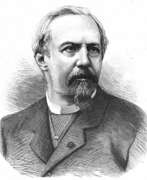

Arthur Warocqué was a Belgian industrialist, philanthropist, politician and artist.
He was the managing director of the coal mining companies Charbonnages de Mariemont and Bascoup, a member of the Belgian House of Representatives, and a collector.
Warocqué also had a passion for painting, studying under the Belgian illustrator Paul Lauters (1806-1876). While traveling through Scandinavia as a young man, Warocqué captured views of Sweden, Norway, and Lapland, from which he published a series of prints.


William Wyld was a British watercolor painter.
Wyld lived most of his life in France and Belgium, where he became a successful watercolorist. He also traveled extensively throughout Europe and North Africa, and his work was greatly admired by Queen Victoria, who commissioned paintings depicting Liverpool and Manchester.
